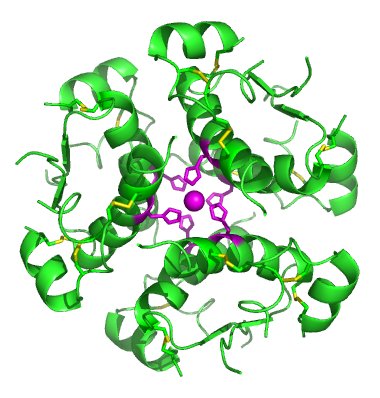
Insulin (from the Latin, insula
meaning island) is a peptide hormone produced by beta cells
in the pancreas.
It regulates the metabolism of carbohydrates
and fats by
promoting the absorption of glucose from the blood to skeletal
muscles and fat
tissue and by causing fat to be stored rather than used for energy. Insulin
also inhibits the production of glucose by the liver.
In 1920,
Dr. Frederick Banting wanted to make a pancreatic extract, which he hoped would
have anti-diabetic qualities. In 1921, at the University of Toronto, Canada,
along with medical student Charles Best, they managed to make the pancreatic
extract.
Their method involved tying a string around the pancrease duct. When examined several weeks later, the pancreatic digestive cells had died and been absorbed by the immune system. The process left behind thousands of islets. They isolated the extracts from the islets and produced isletin. What they called isletin became known as insulin.
Banting and Best managed to test this extract on dogs that had diabetes. They discovered insulin. In fact, they managed to keep a dog, that had had its pancreas taken out, alive throughout the whole summer by administering it the extract (which was, in fact, insulin). The extract regulated the dogs blood sugar levels.
Their method involved tying a string around the pancrease duct. When examined several weeks later, the pancreatic digestive cells had died and been absorbed by the immune system. The process left behind thousands of islets. They isolated the extracts from the islets and produced isletin. What they called isletin became known as insulin.
Banting and Best managed to test this extract on dogs that had diabetes. They discovered insulin. In fact, they managed to keep a dog, that had had its pancreas taken out, alive throughout the whole summer by administering it the extract (which was, in fact, insulin). The extract regulated the dogs blood sugar levels.
At this
point, Professor J. MacLeod, who had placed the laboratory at their disposal,
said he wanted to see a re-run of the whole trial. After doing so he decided to
get his whole research team to work on the production and purification of
insulin.
J.B. Collip joined the scientific team, which now consisted of Banting, Best, Collip and MecLeod. They managed to produce enough insulin, in a pure enough form, to be able to test it on patients.
In 1922 the insulin was tested on Leonard Thompson, a 14-year-old diabetes patient who lay dying at the Toronto General Hospital. He was given an insulin injection. At first he suffered a severe allergic reaction and further injections were cancelled. The scientists worked hard on improving the extract and then a second dose of injections were administered on Thompson. The results were spectacular.
The scientists went to the other wards with diabetic children, most of them comatose and dying from diabetic keto-acidosis.
J.B. Collip joined the scientific team, which now consisted of Banting, Best, Collip and MecLeod. They managed to produce enough insulin, in a pure enough form, to be able to test it on patients.
In 1922 the insulin was tested on Leonard Thompson, a 14-year-old diabetes patient who lay dying at the Toronto General Hospital. He was given an insulin injection. At first he suffered a severe allergic reaction and further injections were cancelled. The scientists worked hard on improving the extract and then a second dose of injections were administered on Thompson. The results were spectacular.
The scientists went to the other wards with diabetic children, most of them comatose and dying from diabetic keto-acidosis.
They went
from bed-to-bed and injected them with the new purified extract - insulin. This
is known as one of medicines most dramatic moments. Before injecting the last
comatose children, the first started to awaken from their comas. A joyous
moment for family members and hospital staff!!
Collip did not get on too well with Banting and Best apparently - and he soon left the project. Best continued trying to improve the extract and managed eventually to produce enough for the hospital's demand. Their work was privately published. The Eli Lilly Company soon got to hear about it and offered to assist. It was not long before the Eli Lilly Company managed to produce large quantities of refined pure insulin.
In 1923 Banting and Macleod were awarded the Nobel Prize in Physiology or Medicine. Banting shared his prize with Best and Macleod shared his with Collip. The patent for insulin was sold to the University of Toronto for one dollar.
Collip did not get on too well with Banting and Best apparently - and he soon left the project. Best continued trying to improve the extract and managed eventually to produce enough for the hospital's demand. Their work was privately published. The Eli Lilly Company soon got to hear about it and offered to assist. It was not long before the Eli Lilly Company managed to produce large quantities of refined pure insulin.
In 1923 Banting and Macleod were awarded the Nobel Prize in Physiology or Medicine. Banting shared his prize with Best and Macleod shared his with Collip. The patent for insulin was sold to the University of Toronto for one dollar.
Referenec-Wikipadia.
No comments:
Post a Comment